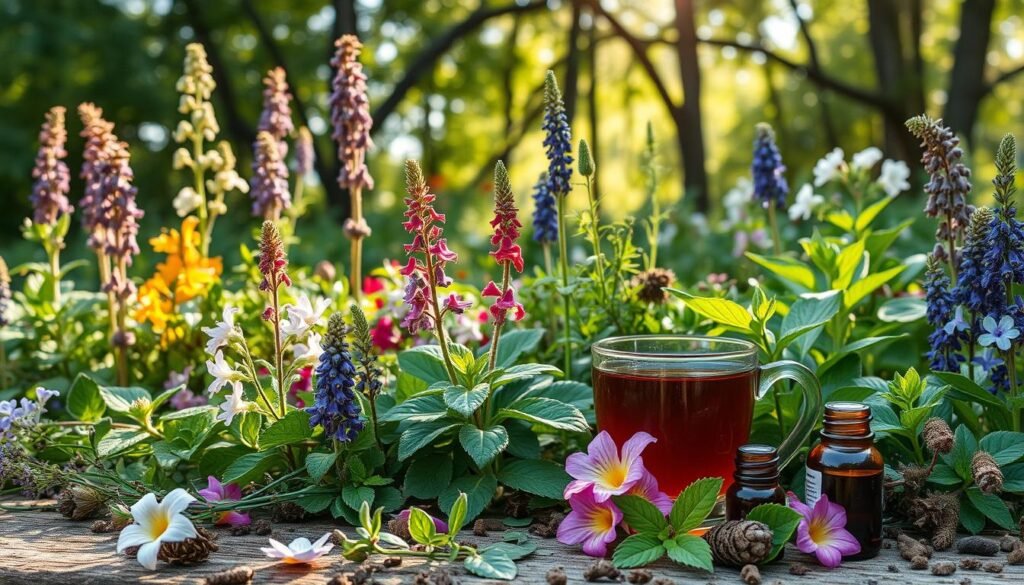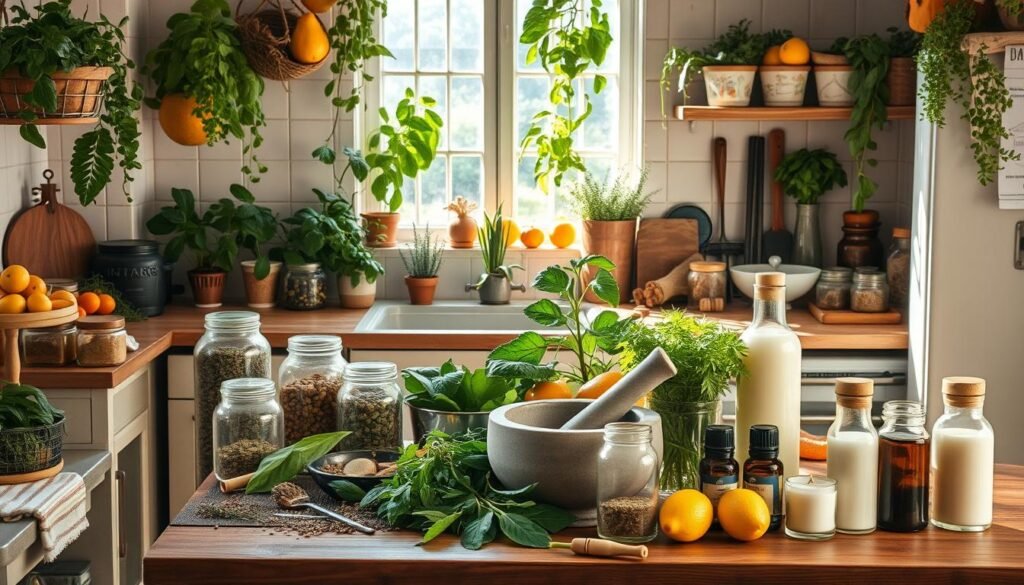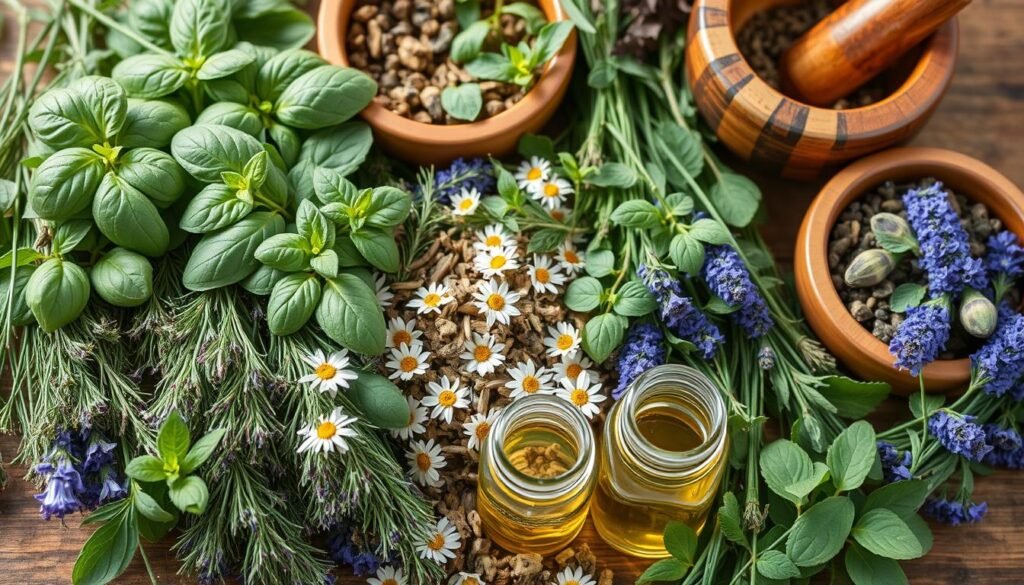Did you know over 60% of adults are now trying natural remedies? They use things like herbal teas and essential oils to feel better. This trend is growing because people are interested in healing methods used for centuries. Practices like drinking ginger tea for nausea or using eucalyptus oil for pain are getting scientific attention. These old remedies might truly help us heal.
Not all these treatments have been fully studied yet. But research is ongoing and showing promising results. When exploring herbal or non-herbal treatments at home, always be safe. It’s important to talk to a doctor or healthcare professional first. For more on effective home remedies, check out WebMD. There, you can find different ways to take care of your health at home.
Key Takeaways
- Natural home remedies are gaining popularity as alternatives for managing health issues.
- Common treatments include turmeric for inflammation and ginger for nausea.
- While effective, many herbal remedies are not regulated like conventional medicines.
- Consulting healthcare professionals is essential before using herbal supplements.
- Labels with certifications like “USP Verified” can guide users toward safer options.
Understanding Natural Home Remedies
Natural home remedies are of two types, including herbal and non-herbal options. Herbal remedies come from plants and can be teas, capsules, or for skin application. They are based on the knowledge of many cultures and help with various health issues.
Non-herbal remedies use things like essential oils and minerals. People like these alternative therapies because they might not have the side effects that medicines do. Around 80% of the world’s population uses herbal medicines for health care, showing their importance in healing.
In Germany, doctors have access to 600 to 700 plant-based medicines. This shows doctors there trust in these remedies. The trend is growing due to the high cost of regular medicine in places like the United States, leading more people to herbal options.
Understanding wellness routines and the history of remedies is key. Knowing about them helps people use herbal medicine wisely. It’s important to research and talk to doctors to use these safely, especially with other medications.
Benefits of Herbal Remedies
Herbal remedies bring benefits tied to holistic healing. Many people use herbal supplements for relief from common issues. For instance, they can help with colds, digestive problems, and anxiety. About 40% to 60% of adults in the U.S. take dietary supplements, including herbs.
Some choose herbs over conventional medicine, a 2018 study found. Older adults and those with more education often prefer herbal options. The World Health Organization says 88% of countries use herbal medicine.
Yet, herbal remedies need careful use. They can react with prescription drugs, sometimes causing side effects. For example, garlic might increase bleeding risk with certain medicines. Knowing about these interactions and herbal safety is vital.
The following table shows some common herbal supplements and risks:
| Herbal Supplement | Potential Risks |
|---|---|
| Aloe Latex | Abdominal pain, cramping |
| Black Cohosh | Risk of liver damage |
| Echinacea | Nausea, stomach pain |
| Ginkgo | Dizziness, stomach upset, risk of bleeding |
| Turmeric | Liver injury, mild dermatitis |

Knowing the good and possible risks of herbal remedies is key. Many find these natural treatments a comforting addition to their health routines. It’s important to focus on safety while using them.
Herbal and Non-Herbal Treatments You Can Do at Home
Many people look for easy and effective ways to improve their health. Herbal and non-herbal treatments are great options that you can fit to your health needs. These therapies let people take charge of their health.
Adding DIY treatments to your daily life is simple. Most remedies use things you have in your kitchen and ingredients you can find easily. For example, drinking chamomile tea or warm milk before bed can help you sleep better. This is especially helpful for the 60 million Americans who have trouble sleeping.
Choosing natural remedies brings big benefits. Aloe vera gel, for example, is great for skin because it fights bacteria. If you have eczema, you might try apple cider vinegar diluted with water. It’s important to watch out for skin irritation, though.
The table below summarizes different herbal and non-herbal treatments you can try at home:
| Treatment | Type | Benefits | Important Notes |
|---|---|---|---|
| Chamomile Tea | Herbal | Aids sleep, reduces anxiety | Limited scientific proof |
| Aloe Vera Gel | Herbal | Soothes skin | Recommended for mild irritations |
| Melatonin Supplements | Non-Herbal | Regulates sleep cycle | Stick to one brand for consistency |
| Warm Milk | Non-Herbal | Helps induce sleep | Not guaranteed to work for everyone |
| Colloidal Oatmeal Lotion | Herbal | Provides antioxidant and anti-inflammatory effects | Useful for itching and dryness |
With the right information and tools, using these remedies can really improve your health and wellness. It’s all about finding what works for you. This way, you can make a health plan that fits your lifestyle, using these herbal and non-herbal treatments.

Common Herbal Remedies
Many people use herbal remedies for health benefits. Turmeric, ginger, and mint are popular options. They have a long history of helping with various health issues.
Turmeric for Pain and Inflammation
Turmeric is a bright yellow spice that helps with inflammation. It contains curcumin, which is great for reducing pain. People use it for arthritis and pain relief.
Adding turmeric to your diet can lessen inflammation-related pain. You can make turmeric tea for comfort:
- 1 teaspoon of ground turmeric
- 1 cup of boiling water
- Add honey or lemon to taste
Drink this tea regularly to feel its effects.
Ginger for Nausea and Pain Relief
Ginger is known for easing nausea and motion sickness. It also helps with headaches and sore throats thanks to its anti-inflammatory effects. Making ginger tea is a simple way to enjoy these benefits:
- 1 tablespoon of freshly grated ginger
- 1 cup of boiling water
- Strain and sweeten to taste with honey
This tea is soothing and warms you up.
Mint for Muscle Pain and Digestion
Mint, like peppermint and wintergreen, is great for soothing. It helps with digestive problems and muscle pain. Mint tea is refreshing and easy to make:
- 1 handful of fresh mint leaves
- 1 cup of boiling water
- Add honey or lemon to enhance flavor
Drinking this tea helps your digestion and relaxes your muscles. To learn more about herbal remedies, visit this resource.

| Herb | Benefits | Preparation |
|---|---|---|
| Turmeric | Reduces pain and inflammation | Turmeric tea with honey and lemon |
| Ginger | Eases nausea and relieves pain | Ginger tea with honey |
| Mint | Soothes digestion and muscle pain | Mint tea with honey or lemon |
Non-Herbal Treatments that Work
Those looking for effective non-herbal remedies often turn to essential oils. Eucalyptus and lavender oils are known for their strong benefits. They improve well-being, making them top picks for treating different health issues.
Eucalyptus Oil for Pain Relief
Eucalyptus oil is praised for its awesome ability to relieve pain. A study in 2022 showed that smelling this oil can ease pain. It also boosts the life quality of those with rheumatoid arthritis.
This oil can be rubbed onto the skin to help with muscle pain and swelling. People love adding eucalyptus oil to their baths or massages. It’s a big part of their relaxation routine.
Lavender for Anxiety and Migraines
Lavender oil is famous for its relaxing effects. It’s proven to lessen the pain of medical procedures like getting a shot. Plus, smelling lavender oil is a great way to fight anxiety and migraines.
You can put it in a diffuser or a warm bath. This helps with calming down and reducing stress.
Self-Care Practices to Incorporate
Self-care is crucial for your health and happiness. By adding wellness habits to your day, you can feel less stressed and more ready for life’s ups and downs. Activities like mindfulness and meditation bring peace and support your health in many ways.
Some self-care practices take just a minute or two. Adding quick things like grounding exercises, enjoying music, or going for short walks boosts your mental and physical health. Creating tech-free areas at home gives you a peaceful spot without taking up too much time.
Some people think self-care means you’re being selfish. But, it really shows you respect and care for yourself. Practicing self-care helps you do better in life and get along with others. Regularly connecting with loved ones strengthens your relationships, which is key for good self-care.
| Self-Care Practice | Benefits | Time Required |
|---|---|---|
| Meditation | Increases mindfulness and reduces stress | 1-5 minutes |
| Grounding Exercises | Enhances emotional stability | 2 minutes |
| Listening to Music | Boosts mood and promotes relaxation | Anytime |
| Short Walks | Improves circulation and reduces anxiety | 5-10 minutes |
| Tech-Free Zones | Encourages mental clarity and relaxation | Varies |
Using herbal products for self-care is becoming popular. You can make herbal body oils at home for a relaxing touch to your routine. Oils like lavender and calendula care for your skin and help you feel calm. If you’re curious about trying these, check out resources for more info on herbal remedies and how to use them, like this helpful guide.
DIY Treatments You Can Easily Make
Making DIY treatments at home is fun and rewarding. You can use common ingredients to make home remedies. These can naturally tackle different health issues. Below, we share some simple recipes focusing on herbal medicine and other natural options.
To create a soothing elderberry syrup, mix dried elderberries with water. Let it simmer for about 30 minutes. After straining, add honey for taste. This syrup is great for fighting viruses, especially during cold and flu season.
- Probiotic yogurt: Adding probiotics to your diet can help with diarrhea after using antibiotics. You can easily make yogurt at home. It’s a good source of those helpful bacteria.
- Arnica cream: Mix 1 part arnica tincture with 4 parts coconut oil to relieve muscle pain. It’s great for bruises and soreness.
- Chamomile tea: Brew chamomile flowers in boiling water for a tea that helps with relaxation and sleep.
Essential oils add extra benefits to DIY projects. Using lavender oil with a carrier oil, for example, can help you relax during a massage.
For skin care, try these easy-to-make face masks:
- Cocoa mask: Mix 1 tablespoon each of cocoa powder, sour cream, honey, and one egg white.
- Oat face mask: Mix 3 teaspoons of ground oats, ¼ teaspoon of apple cider vinegar, ¼ tablespoon of lemon juice, and ½ tablespoon of brown sugar.
- Blueberry face mask: Combine 1 tablespoon of crushed blueberries, lemon juice, cucumber juice, 2 tablespoons of baking soda, and water.
For your hands, try a warm milk soak. Warm 2 to 3 cups of whole milk and soak your hands for 5 to 10 minutes. Coconut oil can moisturize dry cuticles well.
Lastly, it’s smart to talk to a healthcare professional before trying any herbal medicine or DIY treatments. This is especially important if you’re pregnant, breastfeeding, or on medication.
Precautions When Using Herbal Supplements
Herbal supplements are more popular than ever. Americans spend about $13 billion on these products every year. But, it’s crucial to be cautious when using them. Unlike regular drugs, herbal supplements aren’t strictly checked by the U.S. Food and Drug Administration (FDA).
The FDA doesn’t control these products like other meds. Manufacturers don’t have to show that their products are safe or work before selling them. This lack of regulation can be risky.
The process to remove unsafe products by the FDA can take years. This is because the system relies on self-monitoring. Despite the risks, very few supplements have been banned. For example, aloe can cause laxative effects and lower potassium levels. Also, beta-carotene may raise the lung cancer risk in smokers or those exposed to asbestos.
Some products like black cohosh can upset your stomach or affect other medicines. Although it’s not proven yet, black cohosh might harm the liver. Allergies are another issue to watch out for. For example, chamomile can cause reactions in people allergic to ragweed. Similarly, echinacea could be problematic, underlining why consulting healthcare professionals is vital.
Here are some tips for safely using herbal supplements:
- Research the manufacturer and their product quality.
- Understand potential interactions with other medications.
- Always follow the instructions on the label.
- Ask healthcare professionals for advice tailored to you.
- Choose products that have clear labels about standardized formulas and side effects.
By educating yourself and taking the right precautions, you can use herbal supplements safely. This way, you enjoy the benefits of natural remedies without unnecessary risks.
Conclusion
Using natural home remedies for healing offers many choices to improve our well-being. It’s important to know that herbal and non-herbal treatments are valuable for health. Nowadays, products like turmeric and ginger are more popular. In fact, nearly 1 in 5 adults in the U.S. use these natural solutions for health issues.
But, being informed and careful is key when choosing self-care practices. Since herbal medicines aren’t tested as thoroughly as drugs, it’s wise to talk to experts and research. The National Center for Complementary and Integrative Health is a great place for guidance on herbs and supplements.
The balance between empowerment and safety is central to using natural remedies. Creating an informed community allows people to control their health naturally. This way, everyone can truly value the options for holistic care available to them.